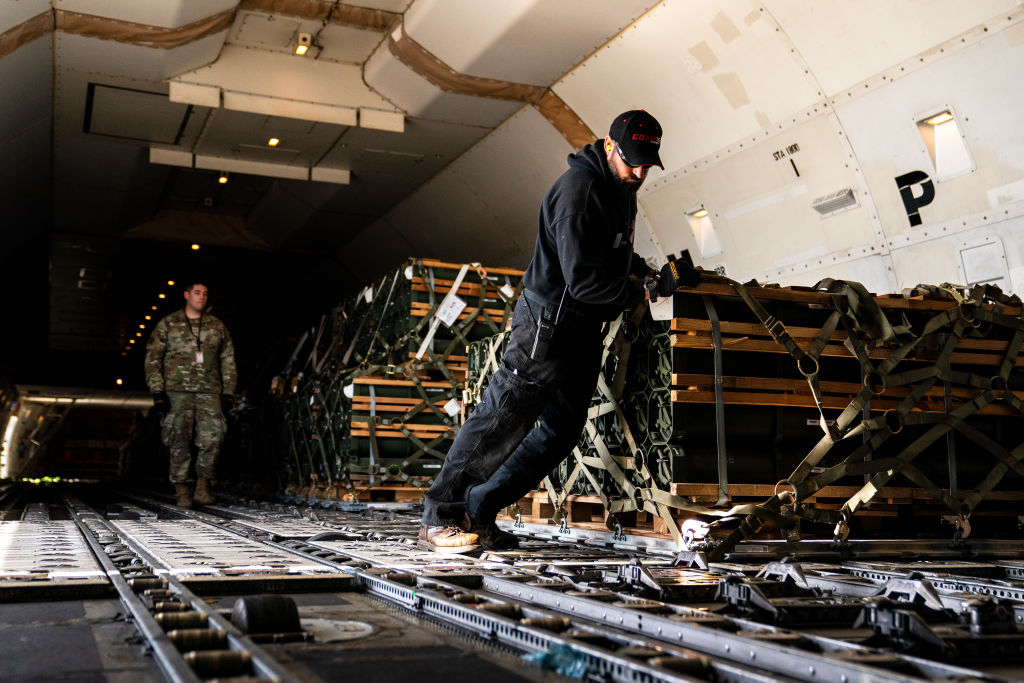
Winter is almost over and the war in Ukraine remains at a standstill. The two armies continue to grind one another down in bloody battles in the east, but the war is no closer to a conclusion. That has to change this spring for the Ukrainians. The concepts of battlefield initiative and operational momentum are often used military terms. An army must seize the initiative from its adversary and then generate momentum on the battlefield in order to attain victory. The Russians have failed here because of manpower and equipment shortfalls, as well as incompetent leadership. The Ukrainians have failed, too. But the cause of their failure has all too often been us, their allies. Since before the war’s inception, the U.S. has consistently been two to three months behind the Ukrainians in their requests for critical military aid. We must close this gap—it’s the only way the Ukrainians can seize the initiative, create momentum, and defeat the Russians.
In the months before the Russian invasion, Ukrainian requested increased military aid to defend themselves. The Biden Administration left these requests largely unfulfilled amidst concerns of provoking Russia and assumptions that the Ukrainian military would prove unable to sustain a robust defense. In the early days of the war, the most visible gesture of U.S. assistance didn’t come in the form of weapons but rather in an offer to evacuate President Zelensky from Kyiv, to which he reportedly replied, “I need ammunition not a ride.” This response would prove apocryphal. For the past year Zelensky has continued his requests for ammunition and equipment, and they have gone only partially heeded, despite a string of Russian upsets on the battlefield.
In those early weeks of the war, it was largely assumed that Russia still possessed the initiative despite their invasion progressing slower than planned. Even as the Russian invasion stalled, the U.S. and NATO proved reluctant to arm Ukraine to capacity. We feared that provoking Putin would result in either a Russian national mobilization or use of a nuclear weapon. Slowly, however, military aid began to arrive in Ukraine throughout that summer. This corresponded with Russia withdrawing its forces from Kyiv as the war concentrated in the east.
By September, Ukraine had at last seized the initiative from the Russians. Armed with long-range artillery systems like HIMARS, Ukraine launched a counter-offensive in the south and the east, liberating over six thousand square kilometers of land from a Russian army that appeared confused and exhausted. Ukraine’s successful counter-offensive made the most pressing case yet that the war could be won. With the cold weather setting in and Russia having lost initiative, the Ukrainians were well-positioned for a winter offensive. That offensive never came. Why not? Because we had left the Ukrainians requests unfulfilled, they lacked the stockpiles of ammunition, equipment, and weaponry they would need to pursue the advantages they had gained. The war stalled yet again.
Read More: A Ukraine Village’s Month in Captivity
Although the Russians—with their numbers buoyed by mercenaries and conscripts—launched several offensives in the winter, those never resulted in meaningful gains. Their operations in Bakhmut and Vulehdar foundered against Ukrainian defenses. The replacement of Russia’s top general in Ukraine this past January is likely an indicator of their underperformance. Today, Russia doesn’t possess the initiative. They have failed to create momentum.
As the war heads into its second spring and the weather turns, both sides will vie for the strategic initiative once again. After Zelensky’s December 2022 visit to Washington, Congress pledged an additional $44 billion in military aid to Ukraine, allowing its military to begin stockpiling ammunition and weapons for the spring. However, NATO and its allies continue to place restrictions on other critical weapons systems such as ATACAMS-long range artillery rounds and F-16 fighter jets, while Leopard and Abrams main battle tanks are arriving at a snail’s pace and in relatively small numbers. The Germans have committed to only 16 Leopard tanks and the U.S. Abrams tanks won’t arrive for months, if this year. These are the platforms that could allow Ukraine to again seize the initiative, as they did this past autumn. Such delays and paltry numbers threaten that success and will almost certainly prolong the war.
If Ukraine is successful in again seizing the initiative from Russia, it’s essential that its NATO allies provide full-logistical support ahead of when it’s needed, not weeks or months later. We can’t dither as we did last fall. We must aggressively backfill ammunition and equipment requests. It’s only by seizing the initiative on the battlefield that armies create momentum. Momentum is an idea as old as war and essential to victory. In The Art of War Sun Tzu writes, “the energy developed by good fighting men is as the momentum of a round stone rolled down a mountain thousands of feet in height.”
The word itself, momentum, is tied to time. To gain momentum Ukraine must create a moment. In this moment, an army seizes the initiative, its adversary finds itself in disarray and, even if outmatched numerically, the psychological effect can lead to astounding territorial, even political, gains. The history of war is the story of these moments, each requiring a degree of synchronization as yet unrealized by Ukraine and its allies.
Without that momentum, this war could grind on. Russia is depending on a conflict slowly won, over years. Ukraine can’t afford that. This spring will be their moment. They have to seize it and we, their allies, have to seize it, too. It might never come again.
More Must-Reads from TIME
- Cybersecurity Experts Are Sounding the Alarm on DOGE
- Meet the 2025 Women of the Year
- The Harsh Truth About Disability Inclusion
- Why Do More Young Adults Have Cancer?
- Colman Domingo Leads With Radical Love
- How to Get Better at Doing Things Alone
- Michelle Zauner Stares Down the Darkness
Contact us at letters@time.com